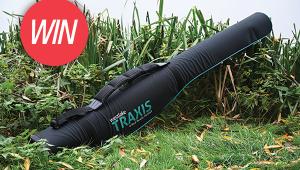Long Whip Fishing - Richard Chave
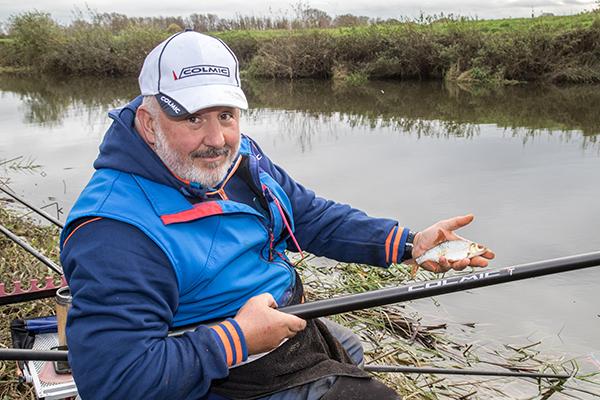
The River Parrett meanders its way through the Somerset Levels and skirts around the town of Langport, and its on this stretch of one of England's lesser-known rivers were we met up with Colmic ace Richard Chave to find out his approach when it comes to catching small silvers from the 20-metre-wide section.
“Looking at the flow and the colour of the water here, it screams out stick and waggler,” he pointed out. “You wouldn't go far wrong by fishing those tactics. However, in a match scenario, it's all about catching a weight, and for me, it's got to be a whip and pole attack.
“Running a float down to feeding fish might produce quality, but get the fish feeding in front of you, and you could catch three or four in the time you've taken to trot, strike and retrieve. When small fish are the target, then speed is paramount, if you want to get ahead of the rest.” For Richard that would be two whips – 6m and 7m Comlic Extreme Superiors, and the new Colmic Nucleare Sixteen S31 – fresh out of the bag.
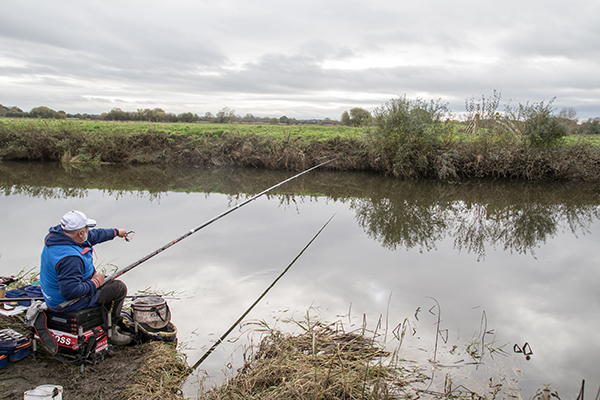
The setup for the 6m whip was a 2g Colmic Zar float, set on 0.12mm of Colmic Steel Resistance mono, with an olivette and trimmers, plus a No8 placed directly above a size 24 swivel. Hook link was 6 inches of 0.08mm Colmic Stream mono and a size 18 Colmic B2000 hook. It was the same on the 7m model, except the float was a 4g Colmic Jolly, plus a heavier olivette.
“The Zar might look a bit slim for the river, but you can hold it back against the flow, if it's not too quick. The bite indication is really good when small silvers are the target, as it offers very little resistance.
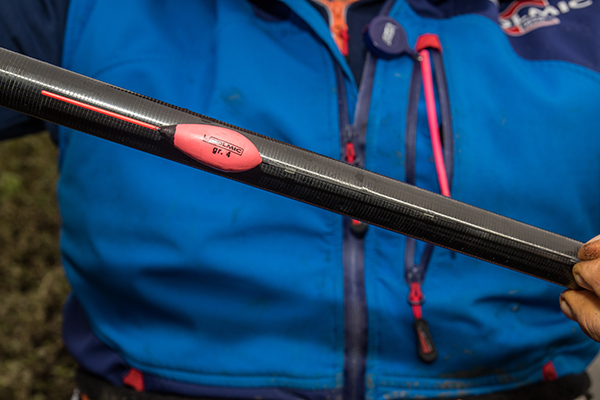
“It is possible that the pace could pick up during the session, if they open the sluice gate downstream at Oath, which is the tidal limit of the river. This area was flooded a week ago, and they will still be running off water from some of the drains, so it is possible.”
Richard explained that his main focus would be catching fish down the middle of the river, but if the action slowed, he would fish at 14.5 metres if he felt the fish had moved further across where there are some far-bank cover that might hold a few bigger fish late on.
The rig for that was a 2g Colmic Titanium Passante, again similar to his whip rigs, but it had an olivette and two droppers and a size 19 Hayabusa 128 hook. Elastic was a 1.5mm Colmic white hollow.
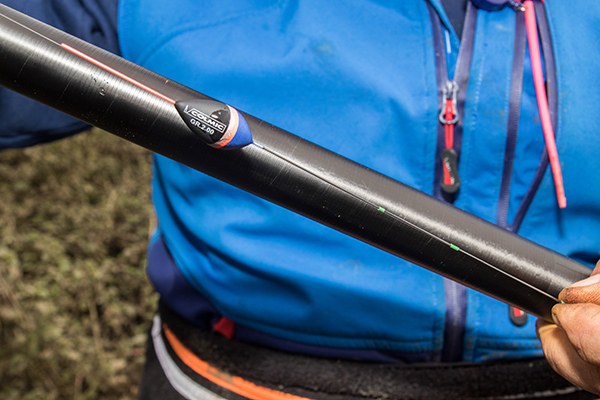
Richard was surprised to find the depth to be only about five feet when he plumbed the 6m setup, and even though there had been a few recent heavy frosts after the rain, he found there to be some remnants of dying eel grass, but not enough to cause too many problems, as he pulled out a few leaves, as he test the depth.
“I might be pulling some more out before it's clear, but there is a nice clear bottom just below it. I did think it would be deeper here, but it's a nice depth for whip fishing, so I should be able to ease the rig through at a good pace.”
To draw the fish to him, Richard had premixed three kilos of his favourite river groundbait – 50/50 of Colmic Impressive and Colmic Black Monster, which he prepared a little on the damp side, as he wanted it to bind with a firm squeeze and sink quickly. It would be the carrier for the dead pinkies and casters he would add.
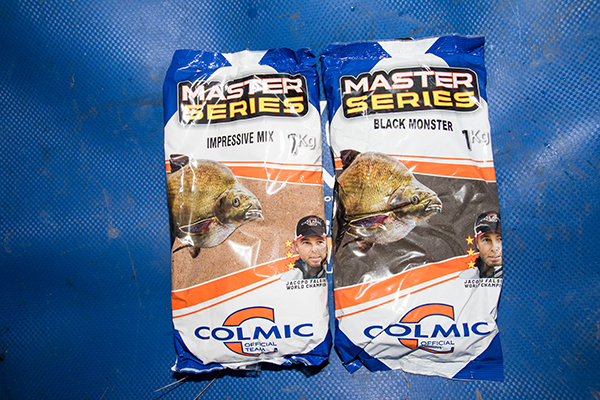
“It's a highly aromatic mix that's great for coloured water. I plan to feed quite aggressively, a nugget every second put-in to keep the fish interested, as I'm expecting to catch skimmers and hydrids along with the roach.
“There are bleak here to, but I'm hoping the lighter particles will move then downstream. I'm going to feed nuggets because of the weed. I don't want to ball it in, just in case I have to fish another line. Once the weed dies off, then I would not have a problem balling in.”
Red maggots were the go to hook bait for the session, and as an added attractant, Richard had hemp, which he would feed initially over the whip line, and with casters to prime the pole line. He also had live pinkies and bronze maggots in reserve for the hook.
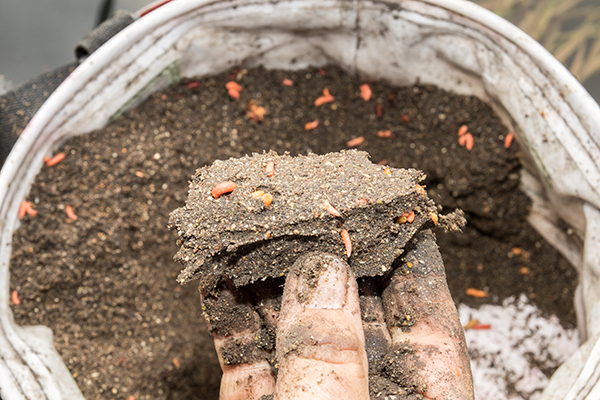
To kick off the session, Richard 'lobbed' two nuggets in front of him, followed by a helping of hemp. He then fired two pouches of the hemp and casters mix across the river.
The bleak were the first to show, and with the fish going to three inches, they were well worth catching until the roach moved in. Richard also found himself having to do a bit of 'gardening', as for the first 20 minutes he regularly pulled in eel grass. However, he soon had a clear channel and was able to trot the full distance unhindered.
A short while after the bleak shoal seemed to have thinned out and the roach moved in, and Richard had a steady run of small fish, plus the odd tiny skimmer. Those fish were taken just below where his feed had settled, and if he failed to get a bite there, then he would pick off a bleak at the end of the trot.
“When I started, I allowed the rig to go with the flow, but I've found that I get more bites when I ease the rig slowly over the feed. The bleak are further downstream, as they've followed the small particles that have come of the feed.
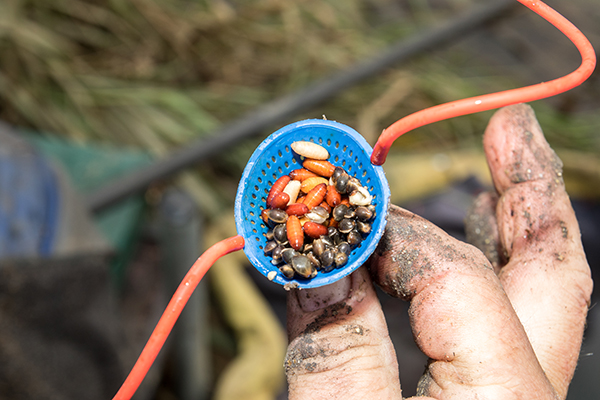
“The roach are small, but I've had the odd better fish, and although I'm very much a 'catch all on a single maggot' guy, I think double maggots might get the bigger specimens.” The switch to the double reds did indeed bring a better stamp of roach, but with a lot of small fish also present, he found that he missed bites more regularly, and even bumped the odd better fish, so as he had been feeding casters with the groundbait, he switched to the 'shells' to see if they would cure the problem.
However...“I can't get a bite on caster. They have to be feeding on them with the groundbait, but wont touch a moving bait, but as soon as I go back to a maggot, they come back. I'm going to ditch the casters on the feed and add maggots instead, as the roach are nailing them on the hook.”
The roach continued to feed, but they were small – nothing more than 3oz, but the action was constant. That was until the massive crash of a predator striking. The big pike scattered the shoal and for 10 minutes after, Richard's catch rate dropped, but the fish did still feed.
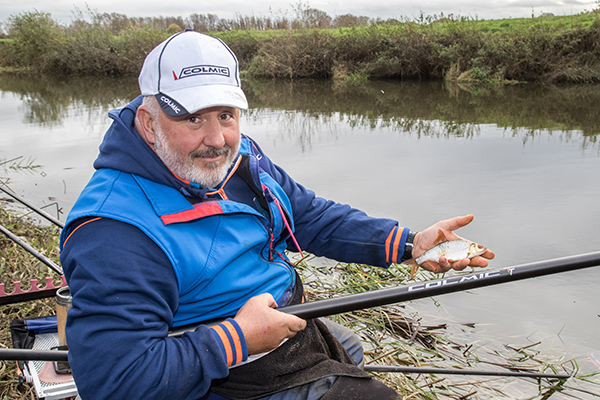
“Where there are silvers, there will always be predators on a river, but it doesn't mean that the fish will stop feeding. They might become a little skittish, but if you keep feeding, they will return slowly, and you should be able to build you swim again.”
It took maybe 15 minutes before the roach begun to feed with confidence again. A while later the bites slowed again. Richard didn't put it down to another predator, but he had noticed that the pace of the water had increased, which had affected his bait presentation. “I'm running the rig through and often not getting a bite, except from a bleak at the limit of my trot. The pace had definitely increased and when I hold back, I think my hook bait is rising too far off the bottom and passing over the fish on my feed.
“I think they have opened the sluice gate downstream to run off some more water. I've added four inches of depth to see if I can keep the bait down. If not, then I'll have to switch to the heavier rig on my 7m whip.”
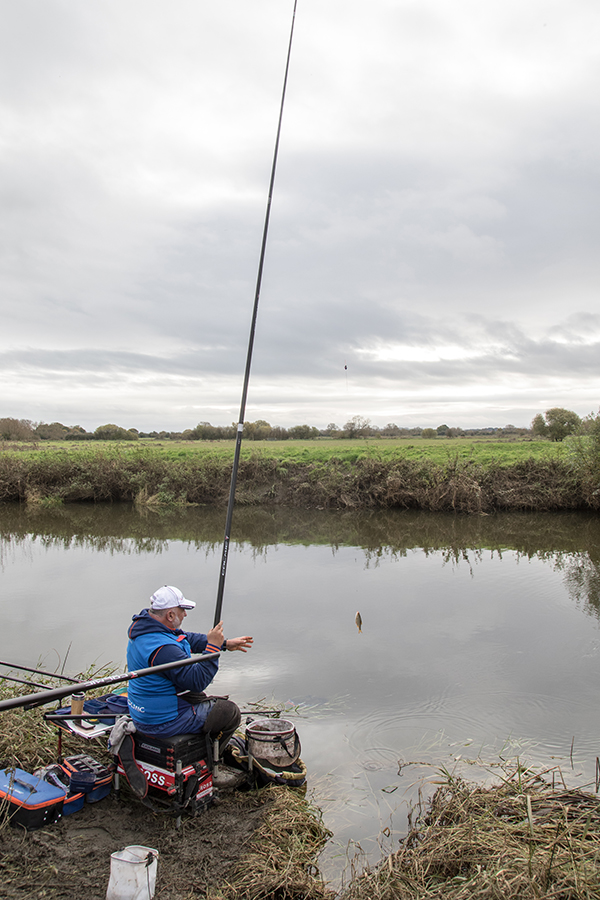
The adjustment did make a difference, but Richard started to catch the roach further downstream, away from his feed. He surmised that the extra pace of the water had dragged his feed further, and so pulled the silvers with it.
“I don't want to loose the fish from in front of me, so I'm going to squeeze the feed really tight, so that it sinks like a stone. It might take a little longer to break down, but I will be able to keep the fish feeding over my catch area.
“I'm also having a problem holding the rig back with the slim float, so I'm switching to my 7m rig with the bigger bodied Jolly and extra bulk, so that I can cope with the extra pace. I'm still fishing over my 6m line. I just have to position the rig on the line before I allow it travel.
The extra control of the 4g float made a big difference, with roach and skimmers being caught over the original feed area that had been topped-up with the tightly-squeezed feed.
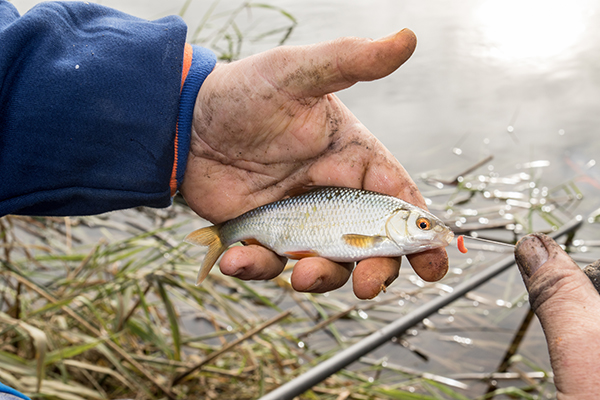
Throughout the session, Richard had been experiencing the odd lost fish, that had been caused by a maggot masking the hook when he fished a double bait, or the fish hadn't take then hook cleanly. “It's partly been a problem solving day, and it's been a little frustrating losing those fish. I've changed my hook link a few times, but that's not completely eliminated the problem, so I'm going to switch to a size 20 hook.
“You might find that a little odd, as you would think that a bigger hook would ensure a better hook-up, but the fish don't feel the weight of a smaller hook, as much as a bigger one, and as the fish that I'm catching are on the small size, by scaling down I'm confident that I will get a more positive hook hold.”
It wasn't 100 per cent success – nothing is, but Richard definitely reduced the number of bumped fish and by sticking with his single maggot option, his bite rate remained constant. Richard had been firing hemp across to his pole line regularly, and to see if he could pick up a better stamp of roach, he felt it was time to switch lines. Again with a single maggot on the hook, he shipped across, laid the rig out and holding it back slightly, he slowly tripped the bait along the bottom.
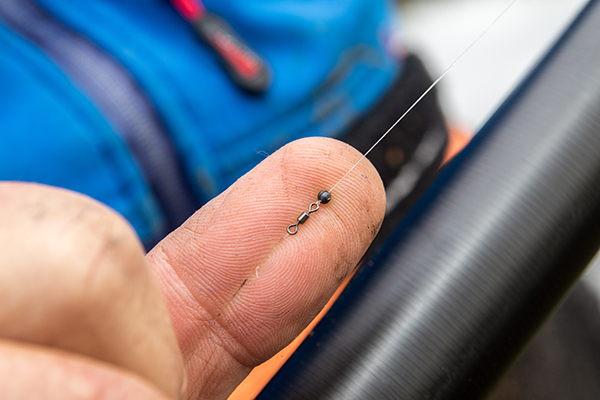
A long line between pole and float allowed Richard to cover a lot of water, and after a few bite-less trots he connected with a nice roach. A few more followed, but the frequency of the bites were too slow.
“It's all about catching quickly in matches on venues like this when the fish are small, so although the roach on my pole line are bigger, I can catch three or even four fish on the whip in the time that I've shipped out, caught a fish and shipped back.”
After ditching the pole line, Richard did fish a little further across, as the 7m whip allowed him to control his rig just off the main feed, and although he continued to catch, he continued to get the best action keeping to the 6m line.
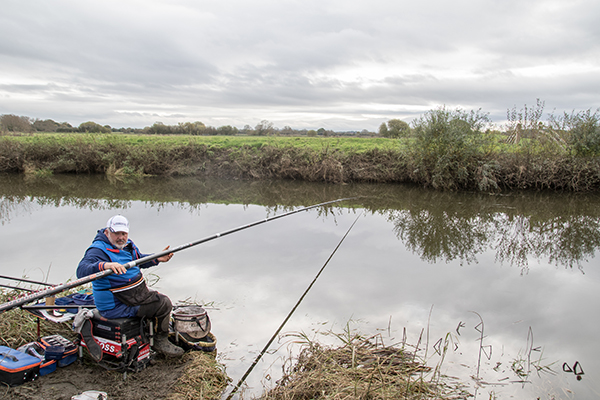
“They tend to fish open matches here on a Tuesday and it's been a good fact-finding session, as I intend to fish a few during the winter, so I have an idea of what works,” Richard concluded. “That doesn't mean to say that it's the same all along this section of river, as I know it does get deeper further downstream.
“I don't think I would fish any differently on another visit, other than I would add maggots to my initial feed rather than casters, as after I switched the roach and skimmers were coughing up maggots when I unhooked them.
“Also, as I hinted at earlier, once the weed has gone, I see no reason not to ball it in at the start and then top-up with nuggets later in the session/match. The most important lesson I've learnt today is to ensure I have an alternative rig for any line, just in case the flow increases, as it did today.
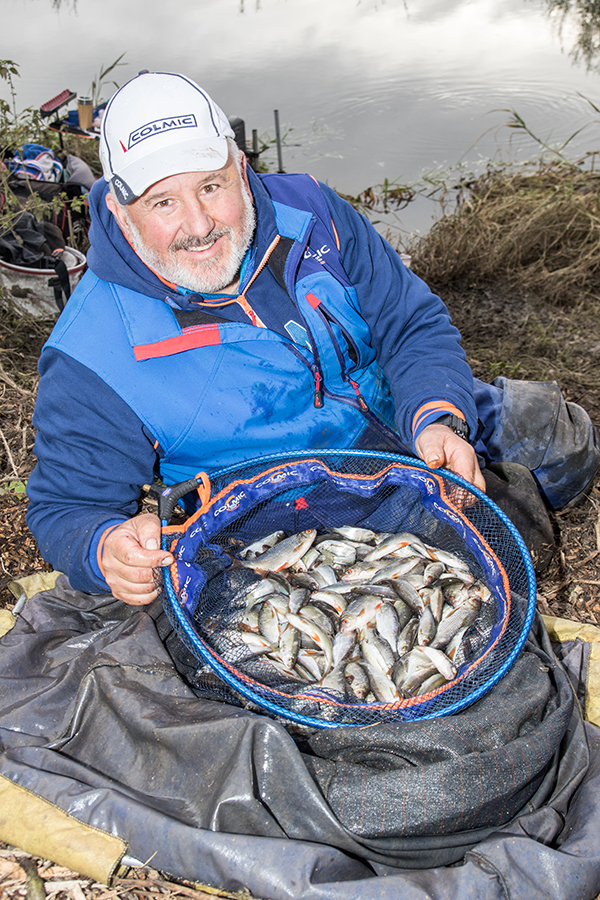
- Log in or register to post comments







